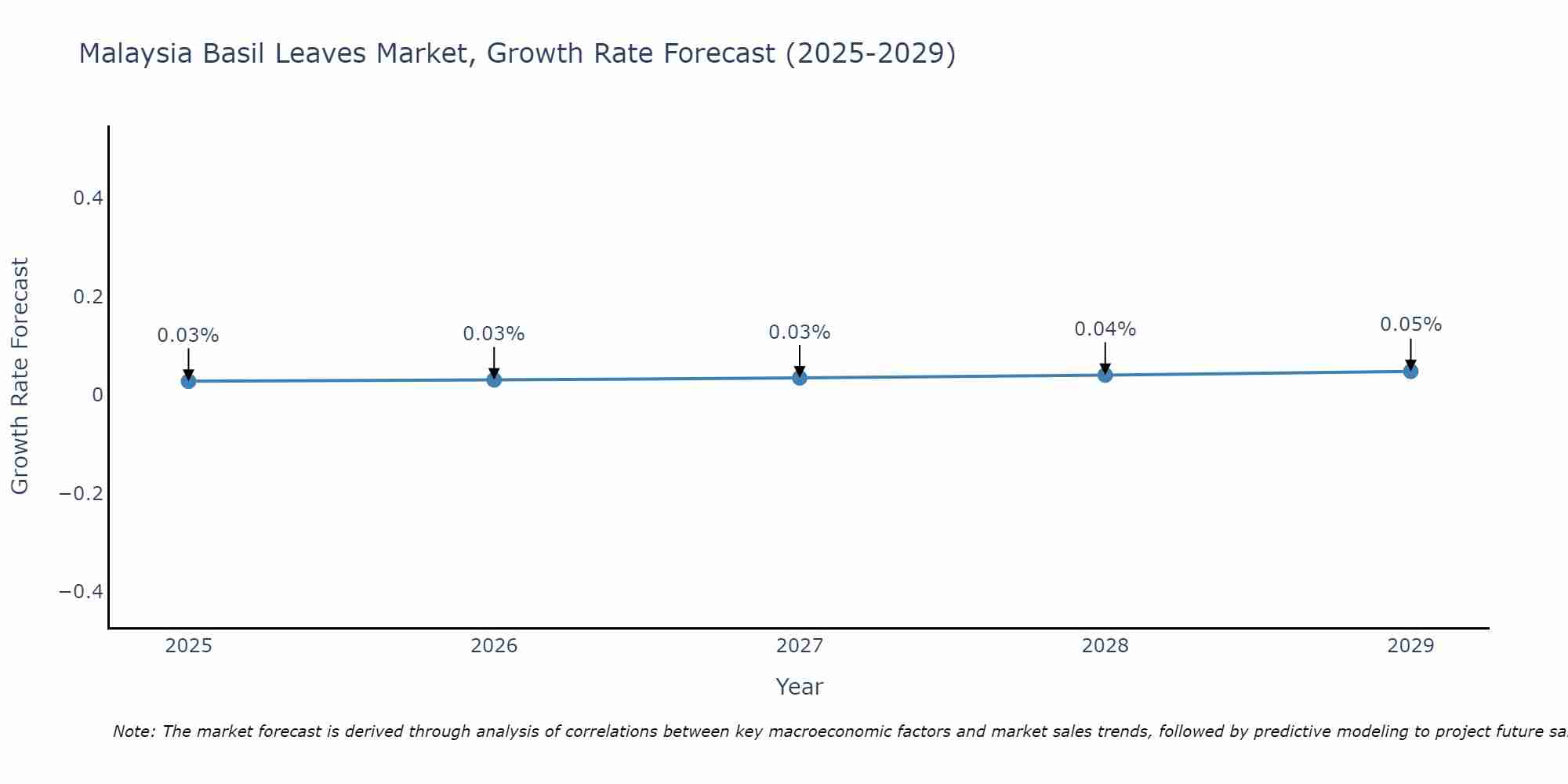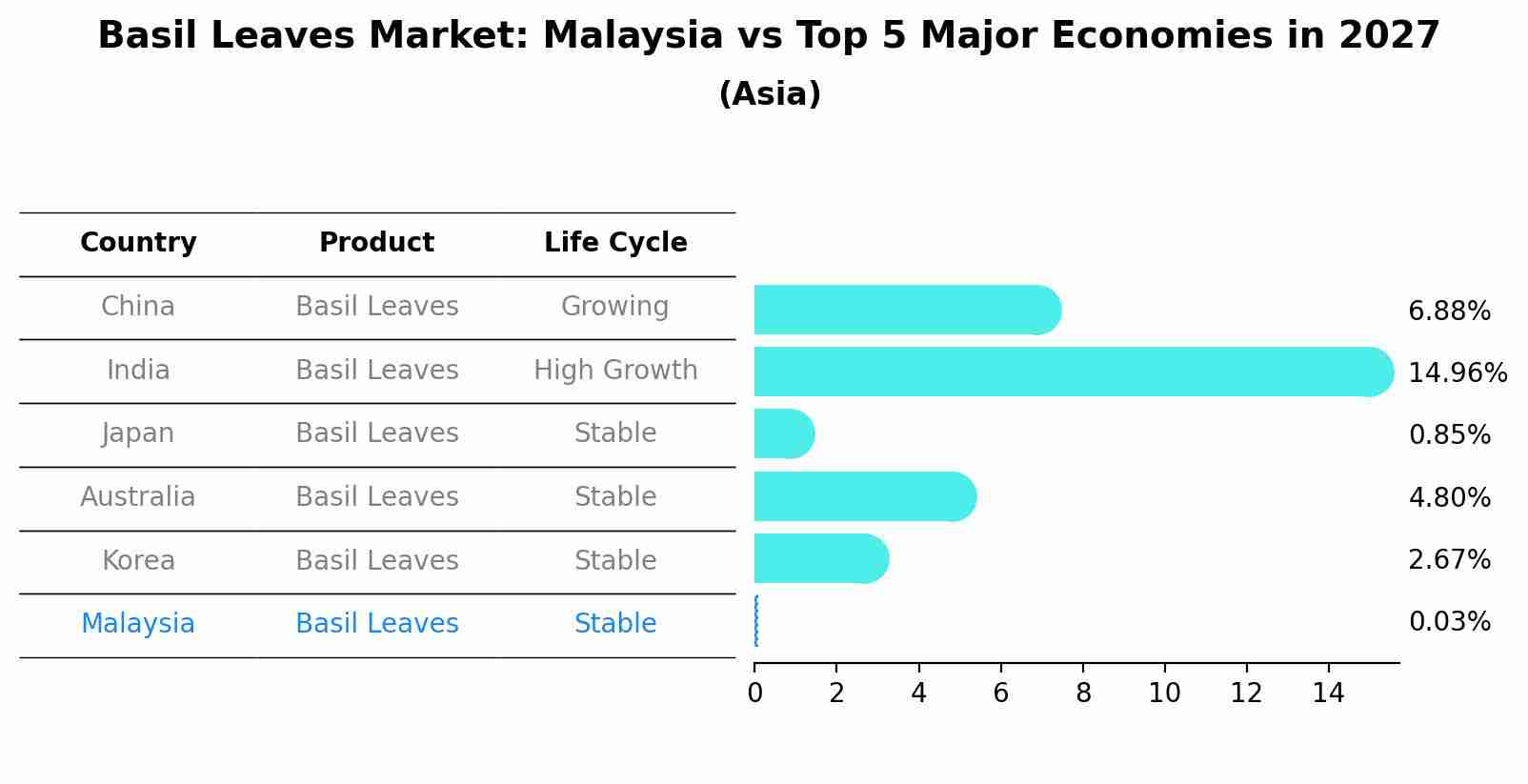Malaysia Basil Leaves Market (2025-2031) Outlook | Share, Revenue, Analysis, Industry, Value, Companies, Trends, Size, Forecast & Growth
| Product Code: ETC219206 | Publication Date: Aug 2022 | Updated Date: Aug 2025 | Product Type: Market Research Report | |
| Publisher: 6Wresearch | No. of Pages: 75 | No. of Figures: 35 | No. of Tables: 20 | |
Malaysia Basil Leaves Market Size Growth Rate
The Malaysia Basil Leaves Market is poised for steady growth rate improvements from 2025 to 2029. Commencing at 0.03% in 2025, growth builds up to 0.05% by 2029.

Basil Leaves Market: Malaysia vs Top 5 Major Economies in 2027 (Asia)
In the Asia region, the Basil Leaves market in Malaysia is projected to expand at a stable growth rate of 0.03% by 2027. The largest economy is China, followed by India, Japan, Australia and South Korea.

Malaysia Basil Leaves Market Synopsis
Basil leaves, a popular herb in Malaysia cuisine, have seen steady demand in the domestic market. Malaysia consumers appreciate the aromatic and flavor-enhancing qualities of basil leaves, making them a staple in various dishes, particularly in traditional and fusion recipes. The market for basil leaves is primarily driven by the foodservice industry, including restaurants and hotels, as well as home cooks who seek to infuse their dishes with fresh flavors. While basil is commonly grown in home gardens, commercial cultivation is also on the rise to meet the increasing demand. The market may witness further growth as chefs and food enthusiasts explore creative applications of basil leaves in both savory and sweet dishes.
Drivers of the Market
The Malaysia basil leaves market is experiencing steady growth, driven by various factors. Firstly, there is an increasing consumer interest in herbal and aromatic ingredients in culinary applications. Basil leaves, with their distinct flavor and health benefits, are gaining popularity among consumers and chefs alike. The growing trend of home cooking and the desire for fresh, natural ingredients are also contributing to the demand for basil leaves. Moreover, the rising awareness of the medicinal properties of basil leaves is driving demand for use in traditional and alternative medicine. With the increasing focus on health and wellness, the Malaysia basil leaves market is expected to continue its positive trajectory.
Challenges of the Market
The Malaysia basil leaves market may face challenges related to seasonal availability and supply chain logistics. Basil is a delicate herb that can be sensitive to weather conditions, affecting its cultivation and availability. Ensuring a consistent supply of fresh basil leaves to meet market demand can be a logistical challenge.
COVID 19 Impact on the Market
The basil leaves market in Malaysia, primarily driven by the foodservice industry and households, also felt the impact of the COVID-19 pandemic. The lockdowns and restrictions on dining out significantly reduced the demand for fresh herbs, including basil leaves. The disruption in the supply chain, including difficulties in importing fresh herbs, further exacerbated the situation. However, the market adapted by exploring opportunities in the online retail sector and focusing on packaging and preservation methods to extend the shelf life of basil leaves.
Key Players in the Market
Basil leaves are a popular herb in Malaysia cuisine, and the market for this aromatic herb continues to thrive. Key players in the Malaysia basil leaves market include local herb farms and suppliers, with names like Cameron Lavender, Malay Herbs, and Farmlink Malaysia supplying fresh basil leaves to restaurants, markets, and consumers.
Key Highlights of the Report:
- Malaysia Basil Leaves Market Outlook
- Market Size of Malaysia Basil Leaves Market, 2024
- Forecast of Malaysia Basil Leaves Market, 2031
- Historical Data and Forecast of Malaysia Basil Leaves Revenues & Volume for the Period 2021-2031
- Malaysia Basil Leaves Market Trend Evolution
- Malaysia Basil Leaves Market Drivers and Challenges
- Malaysia Basil Leaves Price Trends
- Malaysia Basil Leaves Porter's Five Forces
- Malaysia Basil Leaves Industry Life Cycle
- Historical Data and Forecast of Malaysia Basil Leaves Market Revenues & Volume By Product Type for the Period 2021-2031
- Historical Data and Forecast of Malaysia Basil Leaves Market Revenues & Volume By Basil Leaves for the Period 2021-2031
- Historical Data and Forecast of Malaysia Basil Leaves Market Revenues & Volume By Basil Paste for the Period 2021-2031
- Historical Data and Forecast of Malaysia Basil Leaves Market Revenues & Volume By Dried Leaves for the Period 2021-2031
- Historical Data and Forecast of Malaysia Basil Leaves Market Revenues & Volume By End Use for the Period 2021-2031
- Historical Data and Forecast of Malaysia Basil Leaves Market Revenues & Volume By Essential Oils for the Period 2021-2031
- Historical Data and Forecast of Malaysia Basil Leaves Market Revenues & Volume By Pharmaceutical for the Period 2021-2031
- Historical Data and Forecast of Malaysia Basil Leaves Market Revenues & Volume By Snacks for the Period 2021-2031
- Historical Data and Forecast of Malaysia Basil Leaves Market Revenues & Volume By Baked Foods for the Period 2021-2031
- Historical Data and Forecast of Malaysia Basil Leaves Market Revenues & Volume By Beverages for the Period 2021-2031
- Historical Data and Forecast of Malaysia Basil Leaves Market Revenues & Volume By Others for the Period 2021-2031
- Malaysia Basil Leaves Import Export Trade Statistics
- Market Opportunity Assessment By Product Type
- Market Opportunity Assessment By End Use
- Malaysia Basil Leaves Top Companies Market Share
- Malaysia Basil Leaves Competitive Benchmarking By Technical and Operational Parameters
- Malaysia Basil Leaves Company Profiles
- Malaysia Basil Leaves Key Strategic Recommendations
Frequently Asked Questions About the Market Study (FAQs):
1 Executive Summary |
2 Introduction |
2.1 Key Highlights of the Report |
2.2 Report Description |
2.3 Market Scope & Segmentation |
2.4 Research Methodology |
2.5 Assumptions |
3 Malaysia Basil Leaves Market Overview |
3.1 Malaysia Country Macro Economic Indicators |
3.2 Malaysia Basil Leaves Market Revenues & Volume, 2021 & 2031F |
3.3 Malaysia Basil Leaves Market - Industry Life Cycle |
3.4 Malaysia Basil Leaves Market - Porter's Five Forces |
3.5 Malaysia Basil Leaves Market Revenues & Volume Share, By Product Type, 2021 & 2031F |
3.6 Malaysia Basil Leaves Market Revenues & Volume Share, By End Use, 2021 & 2031F |
4 Malaysia Basil Leaves Market Dynamics |
4.1 Impact Analysis |
4.2 Market Drivers |
4.2.1 Growing consumer awareness about the health benefits of basil leaves |
4.2.2 Increasing demand for natural and organic food products |
4.2.3 Rise in popularity of Asian cuisine globally |
4.3 Market Restraints |
4.3.1 Seasonal availability and limited shelf life of fresh basil leaves |
4.3.2 Price fluctuations due to dependency on weather conditions and agricultural factors |
5 Malaysia Basil Leaves Market Trends |
6 Malaysia Basil Leaves Market, By Types |
6.1 Malaysia Basil Leaves Market, By Product Type |
6.1.1 Overview and Analysis |
6.1.2 Malaysia Basil Leaves Market Revenues & Volume, By Product Type, 2021-2031F |
6.1.3 Malaysia Basil Leaves Market Revenues & Volume, By Basil Leaves, 2021-2031F |
6.1.4 Malaysia Basil Leaves Market Revenues & Volume, By Basil Paste, 2021-2031F |
6.1.5 Malaysia Basil Leaves Market Revenues & Volume, By Dried Leaves, 2021-2031F |
6.2 Malaysia Basil Leaves Market, By End Use |
6.2.1 Overview and Analysis |
6.2.2 Malaysia Basil Leaves Market Revenues & Volume, By Essential Oils, 2021-2031F |
6.2.3 Malaysia Basil Leaves Market Revenues & Volume, By Pharmaceutical, 2021-2031F |
6.2.4 Malaysia Basil Leaves Market Revenues & Volume, By Snacks, 2021-2031F |
6.2.5 Malaysia Basil Leaves Market Revenues & Volume, By Baked Foods, 2021-2031F |
6.2.6 Malaysia Basil Leaves Market Revenues & Volume, By Beverages, 2021-2031F |
6.2.7 Malaysia Basil Leaves Market Revenues & Volume, By Others, 2021-2031F |
7 Malaysia Basil Leaves Market Import-Export Trade Statistics |
7.1 Malaysia Basil Leaves Market Export to Major Countries |
7.2 Malaysia Basil Leaves Market Imports from Major Countries |
8 Malaysia Basil Leaves Market Key Performance Indicators |
8.1 Number of new basil leaf product launches in the market |
8.2 Percentage increase in basil leaf cultivation area in Malaysia |
8.3 Adoption rate of basil leaves in various culinary dishes |
9 Malaysia Basil Leaves Market - Opportunity Assessment |
9.1 Malaysia Basil Leaves Market Opportunity Assessment, By Product Type, 2021 & 2031F |
9.2 Malaysia Basil Leaves Market Opportunity Assessment, By End Use, 2021 & 2031F |
10 Malaysia Basil Leaves Market - Competitive Landscape |
10.1 Malaysia Basil Leaves Market Revenue Share, By Companies, 2024 |
10.2 Malaysia Basil Leaves Market Competitive Benchmarking, By Operating and Technical Parameters |
11 Company Profiles |
12 Recommendations |
13 Disclaimer |
- Single User License$ 1,995
- Department License$ 2,400
- Site License$ 3,120
- Global License$ 3,795
Search
Related Reports
- UAE Building Thermal Insulation Market Outlook (2025-2031) | Revenue, Companies, Share, Trends, Growth, Size, Forecast, Industry, Analysis & Value
- Portugal Electronic Document Management Market (2025-2031) | Strategy, Consumer Insights, Analysis, Investment Trends, Opportunities, Growth, Size, Share, Industry, Revenue, Segments, Value, Segmentation, Supply, Forecast, Restraints, Outlook, Competition, Drivers, Trends, Demand, Pricing Analysis, Competitive, Strategic Insights, Companies, Challenges
- France Electronic Document Management Market (2025-2031) | Strategy, Consumer Insights, Analysis, Investment Trends, Opportunities, Growth, Size, Share, Industry, Revenue, Segments, Value, Segmentation, Supply, Forecast, Restraints, Outlook, Competition, Drivers, Trends, Demand, Pricing Analysis, Competitive, Strategic Insights, Companies, Challenges
- Portugal Occupational Health & Safety Services Market (2025-2031) | Strategy, Consumer Insights, Analysis, Investment Trends, Opportunities, Growth, Size, Share, Industry, Revenue, Segments, Value, Segmentation, Supply, Forecast, Restraints, Outlook, Competition, Drivers, Trends, Demand, Pricing Analysis, Competitive, Strategic Insights, Companies, Challenges
- Netherlands Occupational Health and Safety Services Market (2025-2031) | Strategy, Consumer Insights, Analysis, Investment Trends, Opportunities, Growth, Size, Share, Industry, Revenue, Segments, Value, Segmentation, Supply, Forecast, Restraints, Outlook, Competition, Drivers, Trends, Demand, Pricing Analysis, Competitive, Strategic Insights, Companies, Challenges
- Belgium and Luxembourg Facility Management Market (2025-2031) | Strategy, Consumer Insights, Analysis, Investment Trends, Opportunities, Growth, Size, Share, Industry, Revenue, Segments, Value, Segmentation, Supply, Forecast, Restraints, Outlook, Competition, Drivers, Trends, Demand, Pricing Analysis, Competitive, Strategic Insights, Companies, Challenges
- Russia Women Intimate Apparel Market (2025-2031) | Strategy, Consumer Insights, Analysis, Investment Trends, Opportunities, Growth, Size, Share, Industry, Revenue, Segments, Value, Segmentation, Supply, Forecast, Restraints, Outlook, Competition, Drivers, Trends, Demand, Pricing Analysis, Competitive, Strategic Insights, Companies, Challenges
- Africa Chocolate Market (2025-2031) | Size, Share, Trends, Growth, Revenue, Analysis, Forecast, industry & Outlook
- Global Hydroxychloroquine And Chloroquine Market (2025-2031) | Industry, Trends, Size, Outlook, Growth, Value, Companies, Revenue, Analysis, Share, Forecast
- Saudi Arabia Plant Maintenance Market (2025-2031) | Industry, Size, Growth, Revenue, Value, Companies, Forecast, Analysis, Share & Trends
Industry Events and Analyst Meet
Our Clients
Whitepaper
- Middle East & Africa Commercial Security Market Click here to view more.
- Middle East & Africa Fire Safety Systems & Equipment Market Click here to view more.
- GCC Drone Market Click here to view more.
- Middle East Lighting Fixture Market Click here to view more.
- GCC Physical & Perimeter Security Market Click here to view more.
6WResearch In News
- Doha a strategic location for EV manufacturing hub: IPA Qatar
- Demand for luxury TVs surging in the GCC, says Samsung
- Empowering Growth: The Thriving Journey of Bangladesh’s Cable Industry
- Demand for luxury TVs surging in the GCC, says Samsung
- Video call with a traditional healer? Once unthinkable, it’s now common in South Africa
- Intelligent Buildings To Smooth GCC’s Path To Net Zero













